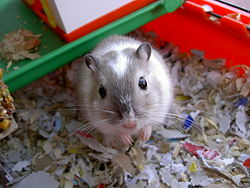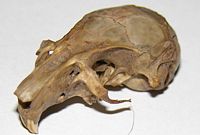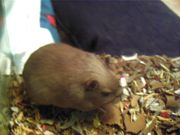Gerbil
2008/9 Schools Wikipedia Selection. Related subjects: Mammals
| Gerbil Fossil range: Late Miocene - Recent |
||||||||||||||
|---|---|---|---|---|---|---|---|---|---|---|---|---|---|---|
 Gerbil
|
||||||||||||||
| Scientific classification | ||||||||||||||
|
||||||||||||||
| Genera | ||||||||||||||
|
Gerbillus |
A gerbil is a small mammal of the order Rodentia. Once known simply as "desert rats", the gerbil subfamily includes about 110 species of African, Indian, and Asian rodents, including sand rats and jirds, all of which are adapted to arid habitats. Most are primarily diurnal (though some, including the common household pet, do exhibit crepuscular behaviour), and almost all are omnivorous.
The word "gerbil" is a diminutive form of " jerboa", though the jerboas are an unrelated group of rodents occupying a similar ecological niche.
One Mongolian species, Meriones unguiculatus, also known as the Clawed Jird, is a gentle and hardy animal that has become a popular pet. It was first brought to the United States in 1954 by Dr. Victor Schwentker for use in research.
Gerbils are typically between six and twelve inches (150 to 300 mm) long, including the tail which makes up approximately one half of their total length. One species however, the Great Gerbil, or Rhombomys opimus, originally native to Turkmenistan, can grow to more than 16 inches (400 mm) in length. The average adult gerbil weighs approximately 2 1/2 ounces. As of August 19, 2003, officials in western China's Xinjiang Uygur Autonomous Region began releasing eagles to combat the damage they say the great gerbils have done to eleven million acres (46,000 km²) of grassland.
Pet gerbils have an average lifespan of 2 to 4 years. Some have been known to live five or six years
Gerbils as Pets
Gerbils were first introduced to the pet industry in 1964. These were the Mongolian gerbils. Their value as pets was soon appreciated and they are now found in pet shops all over the UK and USA. It is illegal to purchase, import or keep a gerbil as a pet in the U.S. State of California.
Life in the Desert
The typical Mongolian gerbil is a desert species, and lives underground in a network of tunnels, which include chambers with families. Adults move away and meet others from other chambers, extend the network, create their own chamber and breed. Gerbils come up for food and water; there is no evidence of hoarding food, but gerbil will eat a lot of fatty foods in one sitting, suggesting supplies in the form of fat reserves rather than food storage. Gerbils do not hibernate and are diurnal. Their long tails help them to balance when they stand up on their hind legs.
Gerbil movement is more like hopping than running, and their large back feet are furry on the bottom to protect them from the heat of the sand. Gerbils are fast but overly inquisitive. In their natural environment, they are mostly insectivores, and additionally gain moisture from desert plants that store water in them. A gerbil is furry allover, including the tail, as this prevents it from getting sun-burned.
Behaviour
General Gerbil Behaviour
Normal gerbil behaviour includes jumping, climbing, chewing, and digging. The digging motions are very common: the gerbil screws its face up and moves its arms rapidly.
Gerbils often stand at a high place and keep lookout for dangers. If they hear a noise, they will usually stand up straighter to investigate. Every so often the "lookout" switches. They are very sensitive to noises and shadows, as the wild gerbils are prey for birds and snakes.
Gerbils are social animals, and prefer to live in groups. Often very large groups live well together, as long as the living environment is big enough, otherwise the gerbils may become frustrated and attack one another. Groups of females are much more quarrelsome than groups of males, but if fighting occurs among males it is usually much more vicious. Males will very rarely attack females, however.
Habits
Food
Sunflower seeds, pumpkin seeds and peanuts are favorites of most gerbils, though they have individual preferences. They also enjoy fruit peels such as orange and banana. In fact, gerbils will eat almost anything; dog biscuits and chews; rat food; rabbit food; guinea pig food; oats; various "special" treats from pet shops, which in fact were not appreciated nearly as much as some parsnip cores. Most weeds dubbed as safe for grazing animals like rabbits or guinea pigs can be eaten by gerbils as well.
Drink
Gerbils metabolise their water from food, like a lot of other desert animals such as Jerboas. Gerbils can go without water for around two weeks, provided they have plenty of food to produce the water, they will always take water if it is available.
Cleansing
Gerbils do not need water to get clean - what cleans them is a sand bath. When taking gerbils out for exercise, a small basin of cool sand will be much appreciated, and true to instinct, a gerbil will roll over in the sand. The effect is instantaneous - their fur becomes much smoother and shinier.
Gerbil Social Behaviour
Gerbils often have what looks like boxing matches - Most common amongst young gerbils (gerbil "pups"). These are gentle play fights which usually end in the winner pinning down the loser and grooming him. Gerbils like to sleep in a group, often on top of each other. Sometimes they will absentmindedly groom each other when half asleep.
Squeaks can occasionally be heard from the them, and a squeak is usually an indication of annoyance. When another gerbil steps on another without thinking, he will give a squeak, or when a gerbil tries to steal another's food, he will turn with a squeak, and when a male tries to mate an unsuspecting female, she may well turn around sharply to face him and squeak at him.
Gerbils do not make eye contact with each other, as for a gerbil this is an aggressive and threatening pose. The female is dominant to the male, so in a mating situation if she turns around and looks at him, he will usually squint and cower to show her he is not threatening her dominance.
Fighting
Gerbils, when fighting, may chase each other around frantically, amid small squeaks of protest by the victim. This is usually a case of bullying by one gerbil. If the feeling is mutual, the gerbils will stare each other down, pounce on one another and clamp their teeth around each other's neck, faces or such in an attempt to draw blood. Gerbils can injure each other seriously in this way. Gerbil fighting is very loud and may last a long time.
Gerbils fighting will usually be on top of each other, rolling over and over rapidly. If gerbils are left to resolve the dispute, they will most likely fight to the death.
A lead up to a fight can include chasing, persistent sniffing and following, and one gerbil forcing another to stay in a single area.
Mating
Gerbils will spend a long time mating, it is frequently short bursts followed by frantic chases. Occasionally, the female will squeak and make flick motions to get the male off of her, normally when he is a stranger. Males will not attack females except in rare circumstances, which include them having been separated from their original mates, or widowed. A female may attack a male, but usually he is more than a match for her.
Raising Young
Gerbil parenting
Mothers have been known to commit infanticide and eat their young, which could be for a number of reasons. If females are forced to share their nest, for example, they would rather kill and eat each others babies to make room for their own. Some gerbil females attack their young once they are weaned if she is expecting another litter: this is when she feels she doesn't have enough space to rear new young, and wants the older gerbils to leave. After one month the babies can be weaned from their mother. Normally in the desert, the gerbils would dig a new network of tunnels and move away when they felt ready.
Males generally leave the young alone, but they do help wash them and such. Interestingly, usually only the mother returns a nestling to the nest if they stumble out. The other gerbils sniff them in order to identify them, but do not pick them up. Mothers can seem rather rough with their babies, picking them up awkwardly in her teeth, kicking the babies out the nest and back in again, and even stepping on them. This, however, is normal behaviour by the mother. If a gerbil is eating its young, it will hold the infant in its hands like it would a piece of food, and run around with it.
It's possible both parents leave nestlings to fend for themselves, as nestlings of a week or so old have a remarkable ability to jump very high, even with their underdeveloped back feet.
Baby stages
When first born, gerbil babies are blind, deaf, furless and helpless. They drink their mother's milk. The young squeak softly when feeding and being picked up. Eventually they grow bigger, and within a week, they have began to show skin pigment, indicating their possible fur colour and markings. Soon after this, a thin downy fur will grow on them, and they will begin to make their fast yet unsteady way out of the nest when the bed is disturbed. This survival technique helps the babies get out of harm's way in case of a territory invasion.
The fur will grow thicker and longer, and by two weeks some of them may have one of their eyes open. Around this point, they begin to be weaned - Eat hard food and not rely so much on milk. At this point, it would help to provide a soft food like an oat and milk mixture for them. After this, the gerbils will become more active, their tails will lengthen and give them more balance so they can stand upright, their ears will open and their mother will stop attempting to put them back into the nest. When fully weaned and beginning to play fight with one another, they will soon be ready to move away, if required.
A mother will often be stern with how quickly the babies are weaned if she is expecting a new litter. A less fertile mother may let her litter suckle for longer. Older mothers often do not have as a good a milk supply, and need plentiful water available to replenish it.
A litter will be of about 4-6 gerbils on average, although losses due to runts, defects and infanticide or occasional, unexplainable persecution from other gerbils sometimes make the eventual litter one or two short.
Sexing
The most common ways of checking the sex of a young gerbil are: 1) Turning the gerbil over and checking the gap size between the genital organs of the gerbil. Female gerbils have a small gap between the two areas, while males have a much larger gap. 2) Although not always clear in childhood and adolescence, male gerbils have a fur covered bulge at the base of their tails, on their underside. This is their scrotal pouch. Females have smooth, round back ends.
Males are generally larger than females in adulthood, in length, height and width. A gerbil can also be sexed by looking at its underside when it is a blind, deaf baby. There will be either a thick line in the middle of the stomach (the scent marker) if it is a male, or eight dots (four on the left side, four on the right) (soon to be teats) if it is a female.
Reasons for popularity
There are several reasons for the popularity of gerbils as household pets. The animals are typically non-aggressive, and they rarely bite unprovoked or without stress. They are small and easy to handle, since they are sociable creatures that enjoy the company of humans and other gerbils. Gerbils also have adapted their kidneys to produce a minimum of waste to conserve body fluids which makes them very clean with little odour.
The pets are incredibly industrious and will explore new environments, and they will build, construct, and enjoy elaborate networks of tunnels if given an environment that allows for it. This is easily observable as gerbils are active during all hours of the day, as opposed to the more nocturnal rodent pets. They can "recycle" everyday paper-based items, such as cardboard products and brown paper bags, into toys and nesting material.
Health concerns
Teeth problems
Misalignment of incisors due to injury or malnutrition may result in overgrowth, which can cause injury to the roof of the mouth. Symptoms include a dropped or loss of appetite, drooling, weight loss, or foul breath.
Trauma
Common injuries are caused by gerbils being dropped or falling, usually while inside of an "exercise ball", which can cause broken limbs or a fractured spine (for which there is no cure).
Neglect
A common problem for all small rodents is neglect, which can cause the gerbils to not recieve adequate food and water, causing serious health concerns, including dehydration, starvation, stomach ulcers, eating of bedding material, and cannibalism.
Wet tail
The most serious intestinal disease of small rodents is "wet tail", or Proliferative Ileitis, which is most common among weaning gerbils (3-6 weeks). Symptoms include lethargy, increased irritability, hunched posture, fluid or bloody diarrhea, a wet, soiled anal area and tail, and, sometimes, rectal prolapse.
Epilepsy
Between 20 percent and 50 percent of all pet gerbils have the seizure disorder epilepsy. The seizures are caused by fright, handling, or a new environment. The attacks can be mild to severe but do not typically appear to have any long-term effects, except for rare cases where death results from very severe seizures.
Tumors
Tumors, both benign and malignant, are fairly common in pet gerbils, and are most common in females over the age of 2. Usually, the tumors involve the ovaries, causing an extended abdomen, or the skin cancer, with tumors most often developing around the ears, feet, mid-abdomen, and base of the tail, appearing as a lump or abscess.
Tail sloughing
Gerbils can lose their tails due to improper handling, being attacked by another animal, or getting their tail stuck. The first sign is a loss of fur from the tip of the tail, then, the skinless tail dies off and sloughs, with the stump usually healing without complications.
Tyzzer's disease
The most common infectious disease in gerbils is Tyzzer's Disease, which is often caused by either stress or bacteria, and produces symptoms such as ruffled fur, lethargy, hunched posture, poor appetite, diarrhea, and often death. It quickly spreads between gerbils in close contact.
Deafness / Inner ear problems
A problem with the inner ear can be spotted by a gerbil leaning to one side quite obviously. The fluids in the ears affect balance. However, this does not appear to affect the gerbils too much, whom have an aptitude of just getting on with things, and getting used to their conditions.
Extremes of Temperature
As desert animals, it is easy to make the mistake that as gerbils are used to bitter cold in the night and boiling heat in the day, they can be left in direct sunlight or in subzero temperatures. This can cause damage to a gerbil. The reason they survive in the desert is because they take frequent shelter in their tunnels. Many gerbils living together and plenty of bedding helps gerbils stay warm. In heat, they will trample their bedding flat. Heat can make gerbils noticeably lethargic, so the choice of shade is important. They do sweat when very hot, and become thirsty more often than usual.
Respiratory Problems
Forgetting to clean a pet gerbil's cage for weeks can be a problem. Ammonia will build up, and gerbils may have trouble breathing. In the wild, gerbils will dig more burrows when their current one is filthy, but in cages this cannot happen. Symptoms of a Respiratory Infection may include: Exhaustion, apathy, and a strange clicking or wheezing noise.
Birth Defects
Gerbils are quite hardy, and it is rare for them to get sick. Seizures are common. Direct inbreeding can be done without too much harm, but it may produce blind or deaf young with short life expectancies, and missing limbs.
Captive-bred gerbil colors
There are many colour varieties of gerbil available in pet shops today generally the result of years of selective breeding.
There are over 20 different coat colors in the Mongolian gerbil, which has been captive-bred the longest.
Another species of gerbil has also been recently introduced to the pet industry: the fat-tailed gerbil, or duprasi. They’re smaller than the common Mongolian gerbils and have long soft coats and a short, fat tail, appearing more like a hamster. There is a variation on the normal duprasi coat which is more gray in colour, which may be a mutation, or it may be the result of hybrids between the Egyptian and Algerian subspecies of duprasi.
White spotting has been reported in not only the Mongolian Gerbil, but also the Pallid Gerbil and possibly Sundervall's Jird.
A long-haired mutation, a grey agouti or chinchilla mutation, white spotting, and possibly a dilute mutation have also appeared in Shaw's Jirds, and white spotting and a dilute mutation have shown up in Bushy-Tailed Jirds.#
When attempting to choose the colour of the gerbil dominant genes and recessive genes must be taken into account, the most comman agouti (brown) colour being on the dominant gene, the recessive albino (white) colour being on the recessive gene, and therefore present in all agouti gerbils.


